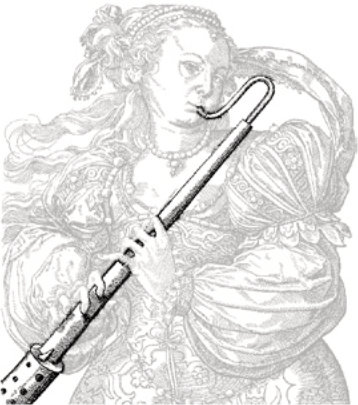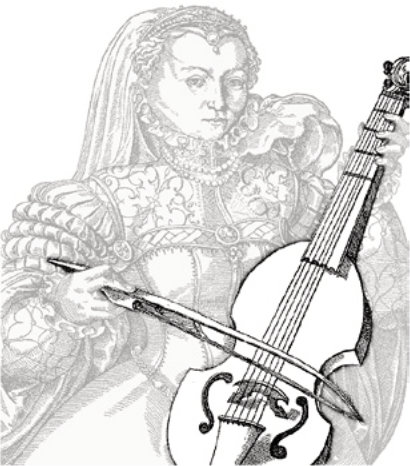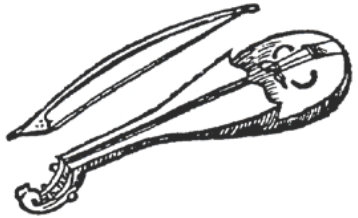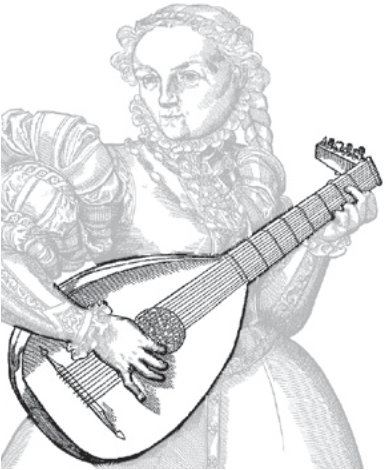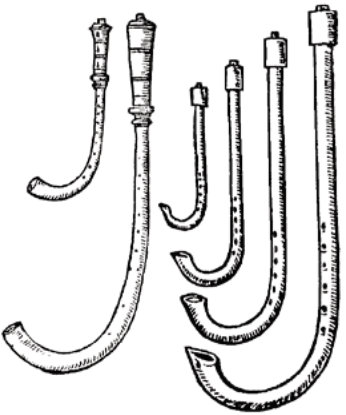Fascinated by the variety of timbres that instruments can produce, Renaissance musicians developed a wide variety of sound colors, ranging from the almost vocal sound of the bowed strings to the chirpy, bird-like sound of the high winds, the twang of the wire-strung cittern, and the buzz of the crumhorns. The sixteenth century musician’s love of variety can be seen in the vast array of instruments imitated by organ stops of the period, by surviving instruments and pictures of instruments, and also by eyewitness accounts of the cornucopia of instruments used to provide music for the lavish banquets of royalty. When a group of instruments is played together, whether they be all of the same family or different, a "consort" is formed.

Flute & Fife
Archaeologists have unearthed flutes that are thousands of years old. More recently — in Europe of the Renaissance (500 years ago) — flutes were made of woodland constructed in a simple manner with a cylindrical bore (internal air passage), six finger holes, and one hole for the player to blow across. Flutes of the Renaissance, like most other instruments of the time, were made in different sizes, from treble to bass. By the year 1700, the instrument we call “Baroque” flute (having a cone-shaped bore and the one key, and three joints to facilitate precise tuning) had been developed. The commonly used flute of the Baroque (often called “traverso” of “flute Allemande” in musical sources to differentiate it from the recorder) evolved from the tenor-sized D flute of the Renaissance, and in turn, over a period of 150 years became, through the addition of keys and change of basic material, the modern silver flute. Although the fife looks like a flute, it has a separate identity. A special category of high-pitched flute which has always been associated with music needing a loud, somewhat shrill sound to be heard outdoors or in noisy situations, the fife was and still is used by the military and in traditional folk dance bands. It has always been made of wood and never had any keys.
Recorder & Whistle
Recorders and whistles are end-blown flutes. The naming of the recorder in various languages reveals aspects of its character or design. In French it 1s called flute à bec (beaked flute), in Italian flauto dolce (sweet flute), in German blockflöte (block flute, which is a reference to the block encased in the blowing end of the instrument), and in English publications it is often simply called “flute,” and, to distinguish it from the transverse flute, the latter instrument is called “German flute.” The recorders used by the Baltimore Consort are of two basic styles, “Renaissance”— a one or two-piece instrument with a cylindrical bore and range of about 1.5 octaves, and “Baroque’’—a three-piece instrument with a conical bore, and larger range, but sweeter, softer sound than the Renaissance instrument. Recorders have seven finger holes on the front and one on the back which can be covered and uncovered by the thumb to activate different octaves. The whistle is similar to a recorder, but has six finger holes instead of seven, and no thumb hole. It is also of lighter construction and can be made of tin as well as wood.
Cittern
A wire-strung plucked wooden instrument, resembling a modern banjo, with a flat back and belly, the cittern flourished in the 16th and 17th centuries. Used to play folk music, it was often depicted on the walls of barber shops, for the use of clients who were waiting to have their hair cut or their blood drawn, but occasionally it was employed in more sophisticated musical settings, especially as a member of the broken consort. The term “cittern,” from the Greek “kithara,” is a manifestation of the Renaissance interest in drawing a parallel between the culture of that time and that of classical antiquity.
Viol
Also known as viola da gamba, this type of bowed instrument flourished between 1500 and 1750. Having evolved in Spain as a hybrid of the vihuela (a fretted guitar-like instrument) and the rebab, a Moorish bowed instrument played in the vertical 8 position, the viol normally had six gut strings. From Spain it ; migrated to Italy and thence spread to northern Europe in the early sixteenth century. The viol experienced a golden age in both consort and solo music in England between about 1540 and 1690, and was also extremely popular in France during the seventeenth and eighteenth centuries, and, since it was associated with the salons of aristocracy and royalty, the instrument fell from use in the late eighteenth century—both because of the French Revolution and due to the ascendancy of the violin family, whose instruments had greater carrying power in the larger public concert halls which were then becoming common.
Rebec
A simple gourd-shaped bowed instrument, held either vertically or on the arm, the rebec came into western Europe in the late Middle Ages with the Crusaders returning from the Middle East. A convenient instrument to carry around, it remained in use at least through the seventeenth century, when it is depicted among the possible types of fiddle employed by dancing-masters. The fiddle itself, as the violin is often called in traditional or dance music, came into being in the early sixteenth century, and was at first used by the servant class of musicians for dance accompaniment. In its early days, the Baltimore Consort used a violin, and later replaced the violin with the more unusual rebec, because its distinctive nasal twang meshes well with the wire-strung instruments.
Lute
A plucked instrument, the lute derives its shape and name from the Arabic instrument still used today, called al-‘ud (or “oud’’), meaning “the wood.” Although we use the lute in consort, it was the most important instrument for solo music in the Renaissance, with an extant repertory of more than 40,000 pieces written between 1500 and 1790. Its function in the Baltimore Consort, besides playing melodies and supplying harmony, is to enliven the texture with scampering ornamental lines and, along with the cittern, to give rhythmic verve to the forward momentum of the music. The lutes heard on this recording have between eleven and nineteen strings. The lute as well as the cittern is played from a musical notation known as tablature, in which each string of the instrument is represented by a line upon which the finger positions (i.e. fret locations) are designated either by letters or numbers.
Bandora
Often referred to as the “pandora,” this wire-strung plucked instrument extended the cittern’s twanginess into the bass range. Developed in England in the 1560s, it had a relatively short life and specific use, its moment of glory involving the role it played in the “broken consort” circa 1600. There is some extant solo music for the instrument, but it was primarily used for accompaniment. One of its most distinctive features is the scalloped shape of its body and the alignment of frets which, due to the slanted bridge and increasing length of its strings from treble to bass range, are splayed further apart on the bass side of the fingerboard than they are on the treble. The family of wire-strung instruments also included a smaller bandora-shaped instrument, the orpharion, which was tuned so that it could play from lute tablature.
Crumhorn
The crumhorn (or “curved horn’’) is a Renaissance wind instrument that didn’t evolve—it is its own cul-de-sac in music history. Though the crumhorn itself died out after the sixteenth century, its characteristic buzzy sound, produced by a double reed encased in a cap at the top of the instrument, 1s still heard as a standard organ stop in the church organs of today. The crumhorn is made of wood; there are four sizes—soprano, alto, tenor, and bass.
Bagpipes
The bagpipes heard here are a set of German Hümmelchen, literally “little bumblebee,” so named for the gentle, buzzing sound of the drone. Their voice is small, compared with the familiar Scottish war pipes, and thus they can be played in ensemble with quiet instruments, even in a duet with the lute as heard in this sound sample.
Gemshorn
Made from the horn of an ox or wild goat which is fitted with a block on the large end, plus finger holes, the gemshorn produces a sweet sound.


